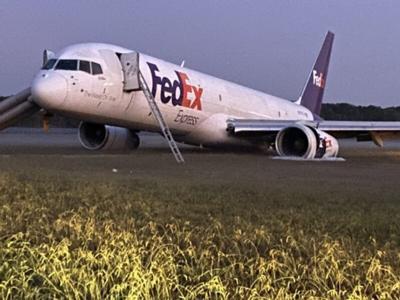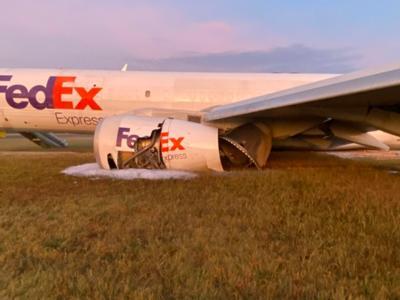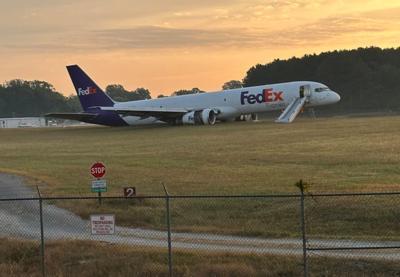None In the Green …
The NTSB has released its preliminary report on a 04 October 2023 in which a Boeing 757-236, registration N977FD, then operating as FedEx flight 1376 from Tennessee’s Chattanooga Metropolitan Airport (CHA) to Memphis International Airport (MEM) was substantially damaged following failure of its left hydraulic system. The accident-aircraft’s two flight crew members and a single jump seat occupant were not injured.

The accident-aircraft was operated as a non-scheduled domestic cargo flight under Part 121 of the Federal Aviation Regulations.
The NTSB set forth:
“On 04 October 2023, at about 23:47 EDT, Federal Express (FedEx) flight 1376, a Boeing 757-236, experienced a failure with its left hydraulic system shortly after takeoff from Chattanooga Metropolitan Airport-Lovell Field (CHA), Chattanooga, Tennessee. The airplane turned back to CHA, and, while preparing to land, the landing gear failed to extend normally. The landing gear also failed to extend using the alternate extend system. The flight crew declared an emergency and the airplane sustained substantial damage during the emergency landing …
“The flight crew reported that the airplane had no maintenance issues before the flight and that the push-back, engine start, and taxi were all uneventful. The captain was the pilot flying, and the first officer was the pilot monitoring. Digital Flight Data Recorder (DFDR) data showed that the airplane departed CHA about 22:24 EDT.
“According to the flight crew, after rotation and confirmation of a positive rate of climb, the First Officer (FO) raised the landing gear control lever to retract the landing gear. DFDR data showed that both the main gear and the nose gear retracted to their up and locked position. About one-minute later, the flap handle was positioned in its up (flaps 0) position. The flight crew reported that immediately thereafter, a ‘TE FLAP DISAGREE’ message was displayed on the Engine Indication and Crew Alerting System (EICAS), along with an associated master caution light, a ‘TRAILING EDGE’ discrete light, and the aural alert caution beeper. Per the captain's direction, the FO began accomplishing the ‘TE FLAP DISAGREE’ checklist in the Quick Reference Handbook (QRH).

“The FO was able to retract the flaps to their up position via alternate means in accordance with the appropriate checklist contained in the QRH. While completing this checklist, the flight crew received an ‘L HYD SYS PRESS’ EICAS message at 22:24:33 at an altitude of about 1,978-feet Above Ground Level (AGL). The status page showed that the left hydraulic system fluid quantity was near zero and that the system was not pressurized. The captain directed the FO to run the QRH checklist for ‘L HYD SYS PRESS’. The flight crew decided to return to CHA.
“Upon positioning the landing gear control lever to its down position to extend the gear for landing, the flight crew received a gear unsafe indication via illumination of the amber ‘GEAR’ disagreement light and a ‘GEAR DISAGREE’ message on the EICAS. Also, the lack of illumination of the three green landing gear indicator lights indicated that the gear was not down and locked. The FO then conducted the ‘Alternate Gear Extension’ procedure embedded in the ‘L HYD SYS PRESS’ checklist, which was unsuccessful. After multiple attempts to lower the landing gear, the flight crew declared an emergency.
“The flight crewmembers asked Chattanooga approach if they could conduct a low approach over the runway so that tower personnel could visually confirm the position of the landing gear. The airplane descended to about 150-feet AGL and flew the length of the runway, which was followed by a go-around. Approach control relayed confirmation that the landing gear was not in the down position. Subsequently, the flight crew completed the deferred items on the ‘GEAR UNSAFE’ QRH checklist and the airplane was cleared to land on runway 20.
“The flight crewmembers reported that during the initial touchdown, the airplane bounced slightly but they were able to maintain directional control and the runway’s centerline. The flight crew was unable to stop the airplane and it slid off the departure end of runway 20 and impacted localizer antennas before coming to rest about 830-feet beyond the end of the runway.
“After the airplane came to a complete stop, the flight crew performed the ‘EVACUATION’ checklist, and the jump seat occupant attempted to open the left-hand door (L1). The door rotated halfway open and then became bound, and the slide did not deploy. The jump seat occupant then attempted to open the right-hand door (R1), but it became lodged on the packing of the raft/slide. The jump seat occupant subsequently forced the door open, and the slide deployed. The flight crew and the jump seat occupant then egressed the airplane via the R1 door/slide.
“Post-accident examination of the airplane revealed that the left main landing gear door actuator retract port hose was leaking hydraulic fluid. The hose was removed and retained by the NTSB for further investigation. The examination also found a discontinuity in the wiring of the landing gear alternate extension system. The section of that wire was retained for further examination.

“The following NTSB specialists were assigned to investigate the accident: systems, survival factors, cockpit voice recorder (CVR), and DFDR. The Federal Aviation Administration (FAA), Federal Express, The Boeing Company, Safran Evacuation Systems, and the Air Line Pilots Association (ALPA) are parties to the investigation.
“The DFDR and the CVR were removed from the airplane and shipped to the NTSB’s Vehicle Recorder Laboratory in Washington, D.C. for download of the data. The DFDR was downloaded, and a review of the preliminary data indicates that the left hydraulic system began losing pressure shortly after takeoff.
“The CVR was downloaded, and the data are currently being analyzed.”
The investigation is ongoing.
The presented information is preliminary and, therefore, subject to change.
Parties interested in learning more about the described occurrence should reference NTSB Accident Number DCA24FA002.
 ANN's Daily Aero-Term (05.05.24): Omnidirectional Approach Lighting System
ANN's Daily Aero-Term (05.05.24): Omnidirectional Approach Lighting System Aero-News: Quote of the Day (05.05.24)
Aero-News: Quote of the Day (05.05.24) Airborne 05.06.24: Gone West-Dick Rutan, ICON BK Update, SpaceX EVA Suit
Airborne 05.06.24: Gone West-Dick Rutan, ICON BK Update, SpaceX EVA Suit Airborne 05.03.24: Advanced Powerplant Solutions, PRA Runway Woes, Drone Racing
Airborne 05.03.24: Advanced Powerplant Solutions, PRA Runway Woes, Drone Racing Aero-News: Quote of the Day (05.06xx.24)
Aero-News: Quote of the Day (05.06xx.24)





